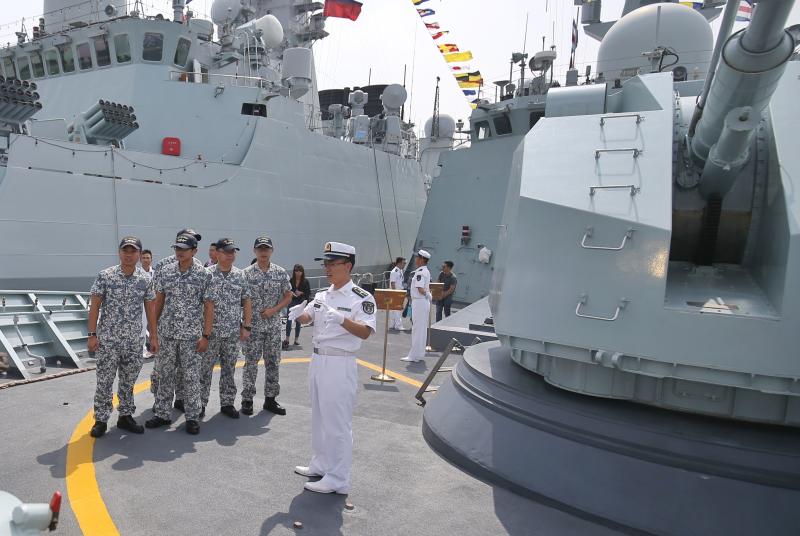First Asean-China Maritime Exercise will tackle simulated collision in waters off Zhanjiang
Sign up now: Get ST's newsletters delivered to your inbox

Crew from the Republic of Singapore Navy frigate RSS Stalwart being given a tour on board the Chinese frigate Huangshan on the third day of the Asean-China Maritime Field Training Exercise.
PHOTO: LIANHE ZAOBAO
Follow topic:
ZHANJIANG, GUANGDONG - A collision between a tanker and a ferry off the waters of Zhanjiang, China, triggers a multi-national search and rescue mission.
This scenario, along with a helicopter evacuation and a maritime replenishment segment, will be part of the first Asean-China Maritime Field Training Exercise.
The exercise culminates in the two-day sea operation which starts on Thursday (Oct 25) and is taking place about 30 nautical miles off Zhanjiang, in China's southern Guangdong province.
The Asean-China Maritime Field Training Exercise, which began on Monday, involves more than 1,000 people from 11 nations. Co-organised by Singapore and China, it is is the first exercise that Asean has held with one other country.
Crucial to the success of the sea operations will be a naval code that serves as the basis of communications between the participating navies, commanding officer of RSS Stalwart, Lieutenant-Colonel (LTC) Aaron Li, said on Wednesday.
The Formidable-class frigate - one of the eight ships involved in the exercise - is representing the Republic of Singapore Navy.
LTC Li said: "For example, if the other countries are unable to say 'I am landing; I am launching my helicopter now', the Code for Unplanned Encounters at Sea (Cues) provides an avenue for you to state your intention, using letters and numbers, without having to articulate it in plain language."
The code thus helps to overcome a key challenge of a multilateral exercise, that of having different languages and the lack of a common communication procedure, he said.
Cues is a non-binding pact first signed in 2014 by 21 countries at a naval conference in China, including China and eight Asean states. Cambodia and Laos were not party to the pact in 2014, which also included Australia, Japan, Russia and the United States.
It specifies safety procedures, communications plans and manoeuvring instructions to reduce the risks of miscalculations.
The recent 5th Asean Defence Ministers' Meeting-Plus that concluded last week reaffirmed the grouping's commitment to subscribe to Cues, which they adopted last year. The other countries involved in the meeting included the United States, China, Japan and Russia.
Commanding officer of the Chinese warship Guangzhou Captain Liu Bin said that they have used Cues when coming into contact with other navies and in the South China Sea.
"For instance, when we are carrying out tasks in the South China Sea, we use Cues to report our speed and intended course of action," he told reporters at the Ma Xie Naval Base in Zhanjiang.
There will be five serials - or components - in the two-day sea phase of the exercise, which will be led by different countries.
The five components are: Manoeuvring in close formation, a communications drill, a joint search-and-rescue operation, helicopter cross-deck landings, and a simulated maritime replenishment.
RSS Stalwart and the Brunei offshore patrol vessel KDB Daruttaqwa will be receiving one Chinese helicopter each during the helicopter cross-deck operation, led by Singapore.
Logistics support vessel BRP Dagupan City from the Philippines will be leading the maritime replenishment component.
Lieutenant (Junior Grade) John Emmanuel Sison, a public affairs officer from the Philippines' Naval Task Group 88, said that whatever sentiments his country had with China over the South China Sea was "irrelevant" and that the team was focused on its mission.
The South China Sea has been a source of tension and concern in the region because of overlapping territorial claims between China and several Asean members - Vietnam, the Philippines, Malaysia and Brunei - as well as Taiwan.
Lt Sison said: "The Philippines Navy is here to establish maritime cooperation. And to learn from each other's experience when it comes to humanitarian and disaster response, especially in implementing Cues."
He added that the exercise would give the Philippine Navy more confidence to manage unplanned encounters with other ships in the future.
"We will ensure that this will be institutional knowledge, not just by us in the contingent, but by everyone in the organisation - to be able to implement Cues when the need arises," he said.

